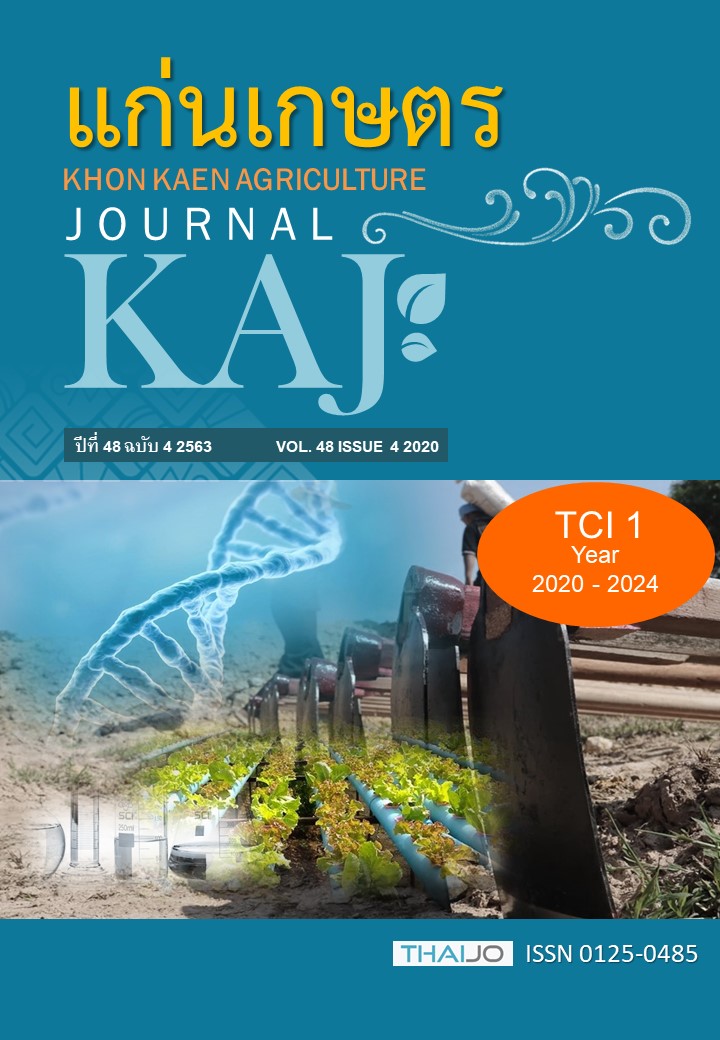อิทธิพลของคุณภาพวัสดุอินทรีย์ต่อพลวัตคาร์บอนในดินผ่านกิจกรรมของจุลินทรีย์ดิน
Main Article Content
บทคัดย่อ
การศึกษานี้มีวัตถุประสงค์เพื่อศึกษากิจกรรมจุลินทรีย์ดินที่ตอบสนองต่อคาร์บอน (C) และ ไนโตรเจน (N) ของวัสดุอินทรีย์ในสภาพการบ่ม ประกอบด้วย 3 กรรมวิธีทดลอง ดังนี้ 1) ดินไม่ใส่วัสดุอินทรีย์ (ควบคุม) 2) ดินใส่ฟางข้าว และ 3) ดินใส่ถ่านชีวภาพ วางแผนการทดลองแบบสุ่มสมบูรณ์ภายในบล็อก (RCBD) จำนวน 3 ซ้ำ ผลการศึกษาพบว่ากรรมวิธีดินใส่ฟางข้าวมีค่า metabolic quotient (qCO2) สูงที่สุด (0.19-0.2 g /MBC/d) และ microbial quotient C (qMic C) สูงที่สุด (547 mg MBC/g soil C) แต่ส่งผลให้อัตราส่วน MBC/MBN ต่ำที่สุด (7.12) ขณะที่กรรมวิธีดินใส่ถ่านชีวภาพส่งผลให้ qMic C ต่ำที่สุด (342 mg MBC/g soil C) การศึกษานี้พบความสัมพันธ์ในทิศทางบวกระหว่างกิจกรรมของ B-glucosidase และ microbial quotient C (qMic C) ในช่วงแรกของการบ่ม (r = – 0.5828*) บ่งชี้เพิ่มเติมว่าคาร์บอนถูกนำไปใช้ได้ง่ายโดยจุลินทรีย์ในช่วงแรกของการย่อยสลาย เป็นที่น่าสนใจว่าในช่วงท้ายของการบ่ม (วันที่ 42-63) พบความสัมพันธ์ในทิศทางบวกระหว่างเอนไซม์ B-glucosidase กับ MBN (r = 0.6993**) และ microbial quotient N (qMic N) (r = 0.5159*) (P <0.05) และความสัมพันธ์ในทางบวกระหว่างเอนไซม์ phenoloxidase กับ MBN (r = 0.6994**) และ qMic N (r = 0.5159*) ความสัมพันธ์นี้ชี้ให้เห็นว่าจุลินทรีย์สามารถปรับกระบวนการชีวสังเคราะห์ตามความต้องการใช้ N ของจุลินทรีย์เพื่อการสังเคราะห์เอนไซม์หมุนเวียนคาร์บอน การศึกษานี้แสดงให้เห็นว่าวัสดุอินทรีย์ที่มี C ย่อยสลายง่ายอย่างเช่นฟางข้าวส่งผลให้จุลินทรีย์ในการใช้ประโยชน์จากคาร์บอนได้ต่ำจึงมีปลดปล่อย CO2 สู่บรรยากาศปริมาณสูง ขณะที่ถ่านชีวภาพมี C ส่วนต้านทานการย่อยสลายสูงช่วยในเก็บกักคาร์บอนในดินได้นานขึ้นโดยการเหนี่ยวนำจุลินทรีย์ดินให้สะสมไว้ภายในเซลล์มากขึ้น
Article Details

อนุญาตภายใต้เงื่อนไข Creative Commons Attribution-NonCommercial-NoDerivatives 4.0 International License.
เอกสารอ้างอิง
Alef, K., and P. Nannipieri. 1995. Methods in Applied Soil Microbiology and Biochemistry. Academic Press, London. 576 p.
Amato, M. and J. N. Ladd. 1988. Assay for microbial biomass based on ninhydrin reactive nitrogen in extracts of fumigated soil. Soil Biol. Biochem. 20:107-114.
Anderson, T. H., and K. H. Domsch. 1993. The metabolic quotient for CO2 (qCO2) as a specific activity parameter to assess the effects of environmental conditions, such as pH, on the microbial biomass of forest soils. Soil Biol. Biochem. 25:393-395.
Arunachalam, A., and H. N. Pandey. 2003. Ecosystem restoration of jhum fallows in Northeast India: microbial C and N along altitudinal and successional gradients. Restor. Ecol. 11:1-6.
Behara, N., and U. Sahani. 2003. Soil microbial biomass activity in response to Eucalyptus plantation and natural regeneration on tropical soil. Forest Ecol. Manage. 174:1-11.
Burns, R. G., J. L. DeForest, J. Marxsen, R. L. Sinsabaugh, M. E. Stromberger, M. D. Wallenstein, M. N. Weintraub, and A. Zoppini. 2013. Soil enzymes in a changing environment: Current knowledge and future directions. Soil Biol. and Biochem. 58:216-234.
Cañizales-Paredes, N., A. Tolon-Becerra, X. B. Lastra-Bravo, and F. M. Ruiz-Dager. 2012. Evaluation of the effects of soil depth on microbial activity in three agroecosystems in Vanezuela. Commun. Soil Sci. Plan. 43:1273-1290.
Coyne, M. S. 1999. Soil Microbiology: An Exploratory Approach. Delmar Publishers, New York. 462 p.
Hendel, B., R. L. Sinsabaugh, and J. Marxsen. 2005. Lignin-degrading enzymes: phenoloxidase and peroxidase. pp. 273-277 In: M. A. S. Graca, F. Barlocher and M. O. Gessner (eds.). Methods to Study Litter Decomposition: A Practical Guide. Springer, Dordrecht.
Hoorman, J. J., and R. Islam. 2010. Understanding soil microbes and nutrient cycling. Available: https://ohioline.osu.edu/ factsheet/SAG-16. Accessed Jan. 24, 2019.
Insam, H. 1990. Are the soil microbial biomass and basal respiration governed by the climatic regime? Soil Biol. Biochem. 22:525-532.
Kamolmanit, B., N. Panwong, and P. Lawongsa. 2018. Influence of biochar to rice straw ratio combined with goat manure on physico-chemical and biological characteristics of compost. Khon Kaen Agr. J. 46:843-856. (in Thai)
Kamolmanit, B., P. Lawongsa, and M. Nopparatmaitree. 2019. Pattern changes of Carbon-cycling enzyme activities as influenced by different C and N availability of organic materials. Khon Kaen Agr. J. 47:1301-1314.
Khattri, S. D., and M. K. Singh. 2009. Removal of malachite green from dye wastewater using neem sawdust by adsorption. J. Hazard. Mater. 167:1089-1094.
Kizito, S., H. Luo, J. Lu, H. Bah, R. Dong, and S. Wu. 2019. Role of nutrient-enriched biochar as a soil amendment during maize growth: exploring practical alternatives to recycle agricultural residuals and to reduce chemical fertilizer demand. Sustainability. DOI: 10.3390/su11113211.
Kunlanit, B., F. Rasche, A. Puttaso, G. Cadisch, and P. Vityakon. 2019. Vertical dynamics of dissolved organic carbon in relation to organic input quality and microaggregate formation in a coarse textured Ultisol. Eur. J. Soil Sci. DOI: 10.1111/ejss.12874.
Kuzyakov, Y., J. K. Friedel, and K. Stahr. 2000. Review of mechanisms and quantification of priming effect. Soil Biol. Biochem. 32:1485-1498.
Limwikran, T., I. Kheoruenromne, A. Suddhiprakarn, N. Prakongkep, and R. J. Gilkes. 2019. Most plant nutrient elements are retained by biochar in soil. Soil Syst. DOI: 10.3390/soilsystems3040075.
Puttaso, A., P. Vityakon, P. Saenjan, V. Trelo-ges, and G. Cadisch. 2011. Relationship between residue quality, decomposition patterns, and soil organic matter accumulation in a tropical sandy soil after 13 years. Nutr. Cycl. Agroecosys. DOI 10.1007/s10705-010-9385-1.
Rowell, D. L. 1997. Soil Science: methods and application. John Wiley & Sons, Inc. New York.
Walkley, A. 1947. A critical examination of a rapid method for determining organic carbon in soils - effect of variations in digestion conditions and of inorganic soil constituents. Soil Science. 63: 251-264.
Wang, W.J., R.C. Dalal, P.W. Moody, and C.J. Smith. 2003. Relationships of soil respiration to microbial biomass, substrate availability and clay content. Soil Biol. Biochem. 35:273-284.
Warnock, D. D., D. L. Mummey, B. McBride, J. Major, J. Lehmann, and M. C. Rillig. 2010. Influences of non-herbaceous biochar on arbuscular mycorrhizal fungal abundances in roots and soils: Results from growth-chamber and field experiments. Appl. Soil Ecol. 46:450-456.
Xiao, S., Z. Zhang, W. You., J. Liu, J. Wu, C. Cai, L. Wu, Z. Ji, and D. He. 2018. Soil microbial community composition in four Nothotsuga longibracteata forests in southern China. Pol. J. Environ. Stud. 27:917-925.
Xu, X., K. Inubushi, and K. Sakamoto. 2006. Effect of vegetations and temperature on microbial biomass carbon and metabolic quotients of temperate volcanic forest soils. Geoderma. 136:310-319.


